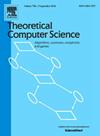Reachability in restricted chemical reaction networks
IF 1
4区 计算机科学
Q3 COMPUTER SCIENCE, THEORY & METHODS
引用次数: 0
Abstract
The popularity of molecular computation has given rise to several models of abstraction, one of the more recent ones being Chemical Reaction Networks (CRNs). These are equivalent to other popular computational models, such as Vector Addition Systems and Petri-Nets, and restricted versions are equivalent to Population Protocols. This paper continues the work on core reachability questions related to Chemical Reaction Networks; given two configurations, can one reach the other according to the system's rules? With no restrictions, reachability was recently shown to be Ackermann-complete, which resolved a decades-old problem.
In this work, we fully characterize monotone reachability problems based on various restrictions such as the allowed rule size, the number of rules that may create a species (k-source), the number of rules that may consume a species (k-consuming), the volume, and whether the rules have an acyclic production order (feed-forward). We show PSPACE-completeness of reachability with only bimolecular reactions in two-source and two-consuming rules. This proves hardness of reachability in a restricted form of Population Protocols. This is accomplished using new techniques within the motion planning framework.
We give several important results for feed-forward CRNs, where rules are single-source or single-consuming. We show that reachability is solvable in polynomial time as long as the system does not contain special void or autogenesis rules. We then fully characterize all systems of this type and show that with void/autogenesis rules, or more than one source and one consuming, the problems become NP-complete. Finally, we show several interesting special cases of CRNs based on these restrictions or slight relaxations and note future significant open questions related to this taxonomy.
受限化学反应网络中的可达性
分子计算的普及已经产生了一些抽象模型,最近的一个是化学反应网络(crn)。这些相当于其他流行的计算模型,如矢量加法系统和Petri-Nets,而限制版本相当于人口协议。本文继续研究与化学反应网络相关的核心可达性问题;给定两种配置,根据系统的规则,其中一种可以到达另一种吗?在没有限制的情况下,可达性最近被证明是阿克曼完全的,这解决了一个几十年的问题。在这项工作中,我们基于各种限制充分表征单调可达性问题,例如允许的规则大小,可能创建物种的规则数量(k-source),可能消耗物种的规则数量(k-consuming),体积以及规则是否具有无循环生产顺序(前馈)。我们证明了双源双消耗规则下双分子反应的可达性的pspace完备性。这证明了《人口议定书》在有限形式下的可达性的困难。这是在运动规划框架内使用新技术完成的。我们给出了前馈crn的几个重要结果,其中规则是单源或单消费的。我们证明了只要系统不包含特殊的空规则或自生规则,可达性在多项式时间内可解。然后,我们充分描述了所有这类系统的特征,并证明了使用无效/自生规则,或多个源和一个消费,问题成为np完全的。最后,我们展示了基于这些限制或轻微放松的几个有趣的crn特殊案例,并指出了未来与该分类法相关的重要开放问题。
本文章由计算机程序翻译,如有差异,请以英文原文为准。
求助全文
约1分钟内获得全文
求助全文
来源期刊

Theoretical Computer Science
工程技术-计算机:理论方法
CiteScore
2.60
自引率
18.20%
发文量
471
审稿时长
12.6 months
期刊介绍:
Theoretical Computer Science is mathematical and abstract in spirit, but it derives its motivation from practical and everyday computation. Its aim is to understand the nature of computation and, as a consequence of this understanding, provide more efficient methodologies. All papers introducing or studying mathematical, logic and formal concepts and methods are welcome, provided that their motivation is clearly drawn from the field of computing.
 求助内容:
求助内容: 应助结果提醒方式:
应助结果提醒方式:


